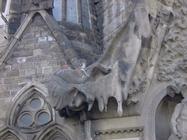
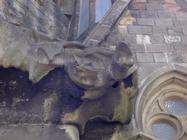 Two chameleons that flanked the facade. The one on the left is going after a
tasty bug.
Two chameleons that flanked the facade. The one on the left is going after a
tasty bug.
Barcelona is the second largest city in Spain and the capital of the province Catalunya. Catalunya is like Quebec in that it has its own language and cultural identity and isn't all that thrilled about being associated with a larger, governing country. Catalunya has been declared an "autonomous community" by Spain and has its own national police force.
The main reason we wanted to see Barcelona was to visit several
buildings by the architect
Antonio Gaudí, a native Catalunian who lived
from 1852 to 1926. Most of his works are located in and around Barcelona and
are classified as "modernisme", part of the Art Nouveau movent.
The Sagrada Familia Cathedral (Cathedral of the Sacred Family) was
started in 1882 by another architect, but was handed over to the young
Gaudí after the first architect left the project. Gaudí took
plans for a traditional-looking cathedral and transformed them into a
huge, unique structure which is still being constructed today.
This is the facade that was completed in Gaudí's lifetime. It
is very organic with flowing figures and forms. The animal carvings are very
realistic, much to Megan's delight. Everywhere you look in
this facade you discover something new peering out at you.

 Two chameleons that flanked the facade. The one on the left is going after a
tasty bug.
Two chameleons that flanked the facade. The one on the left is going after a
tasty bug.
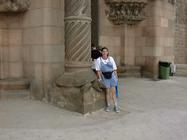
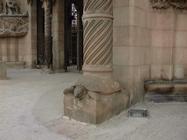 The tortoise supporting one of the main columns. The other column was supported
by a sea turtle.
The tortoise supporting one of the main columns. The other column was supported
by a sea turtle.
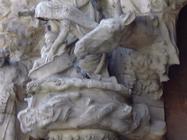 The infant Jesus, the Virgin Mary, and the donkey that carried them to
Bethlehem. When Gaudí told city officials that he needed a
donkey as a model, they brought him the "prettiest donkey in
Barcelona." But Gaudí wanted realism, and saw an old woman with
a run-down, tired old donkey pulling a flower cart down the
street. Gaudí finally convinced the reluctant woman to let him
borrow her animal, but when she saw her donkey covered in plaster to
make the molds, she started to cry because she thought her donkey was
going to die. (This is one of Guy's favorite stories about the cathedral).
The infant Jesus, the Virgin Mary, and the donkey that carried them to
Bethlehem. When Gaudí told city officials that he needed a
donkey as a model, they brought him the "prettiest donkey in
Barcelona." But Gaudí wanted realism, and saw an old woman with
a run-down, tired old donkey pulling a flower cart down the
street. Gaudí finally convinced the reluctant woman to let him
borrow her animal, but when she saw her donkey covered in plaster to
make the molds, she started to cry because she thought her donkey was
going to die. (This is one of Guy's favorite stories about the cathedral).
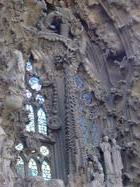 One of the few areas with stained windows installed. It looks like a
few windows were put in place to see if they would work out and the
rest left until some undetermined later date. This shot is taken from the
outside; there is sunlight streaming through the windows because the building
behind them is not complete.
One of the few areas with stained windows installed. It looks like a
few windows were put in place to see if they would work out and the
rest left until some undetermined later date. This shot is taken from the
outside; there is sunlight streaming through the windows because the building
behind them is not complete.
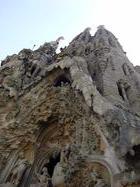 The top of the facade and the towers rising overhead. When people
complemented Gaudí on how nice the brown stone of the facade
looked, he would reply that he was planning on repainting everything
in bright colors once it was complete.
The top of the facade and the towers rising overhead. When people
complemented Gaudí on how nice the brown stone of the facade
looked, he would reply that he was planning on repainting everything
in bright colors once it was complete.
This facade was very recently completed. The figures are by the
sculptor Josep M. Subirachs. This facade is very different than the
Nativity facade, but the sharp angles, straight lines, and austerity
reflect the somber theme of this work.
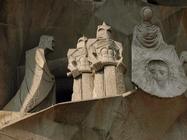 The heads on these soldiers are supposed to be reminiscent of the chimney
sculptures on the Casa Milá, another one of Gaudí's works.
I don't think the resemblance to Star Wars Stormtroopers was intentional.
The heads on these soldiers are supposed to be reminiscent of the chimney
sculptures on the Casa Milá, another one of Gaudí's works.
I don't think the resemblance to Star Wars Stormtroopers was intentional.
Photos taken on our climb to the top of one of the ... ft towers.
The stairwell was narrow and packed with people going up, down, stopping
to take pictures, stopping to conquer their fear of heights, trying to
get on the elevator, trying to get away from the elevator (which I
overheard one person describe as "being built by 19th century sadistic
munchkins")....
But we made it to the top, where the German next to me broke out into
"It's the End of the World as We Know It" by REM. International travel
is fun.
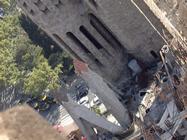 The smaller structures with brighter stone are the windows to the nave. Each
window is topped with fruit, colored by mosaics.
The smaller structures with brighter stone are the windows to the nave. Each
window is topped with fruit, colored by mosaics.
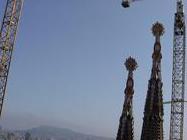
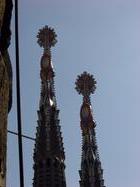
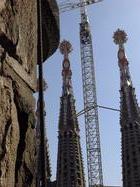 These towers have "Excelsis" and "Hosana" spelled out at the top, along with
brightly colored mosaic crosses. These photos do not capture the neon-bright
intensity of the colors when seen in the sunlight.
These towers have "Excelsis" and "Hosana" spelled out at the top, along with
brightly colored mosaic crosses. These photos do not capture the neon-bright
intensity of the colors when seen in the sunlight.
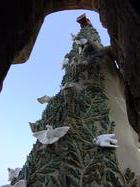 The Nativity Facade is topped by a cyprus tree and white doves, which
you could get close to by walking along the connector between the two
sets of towers on this side of the building.
The Nativity Facade is topped by a cyprus tree and white doves, which
you could get close to by walking along the connector between the two
sets of towers on this side of the building.
As this structure is funded by public donations, visitors are allowed to view the construction in progress. We visited on a Sunday and did not get to see anyone working, but wandering around the site was impressive.
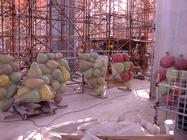 More fruit, ready to be placed on top of newly constructed nave windows.
More fruit, ready to be placed on top of newly constructed nave windows.
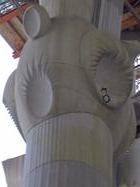 Part of one of the columns of the interior nave.
Part of one of the columns of the interior nave.
This public park originally began as a project to build a subdivision on
the (then) outskirts of the city of Barcelona. Gaudí's long time
patron Eusebi Güell commissioned him to design 60 houses that were
to be nestled on a garden-like landscaped hillside, along with areas such
as plazas and shopping centers that were to build a sense of community for
the residents. Gaudí worked on the project from 1910 to 1914. Only
two houses, along with a plaza and marketplace, were ever built. The area
was opened as a public park in 1922.
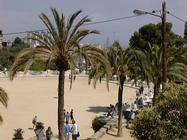
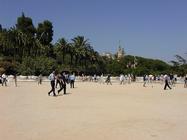 Views of the plaza. There were signs up that read "No soccer playing".
Views of the plaza. There were signs up that read "No soccer playing".
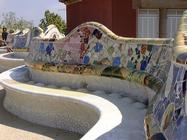
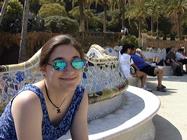 This long, snakelike bench covered in mosaics winds all the way around the plaza. The back side of the bench acts as a water collection unit- when it
rains, the collected water flows to a reservoir. When the reservoir becomes
too full, water drains through several fountains in the park.
This long, snakelike bench covered in mosaics winds all the way around the plaza. The back side of the bench acts as a water collection unit- when it
rains, the collected water flows to a reservoir. When the reservoir becomes
too full, water drains through several fountains in the park.
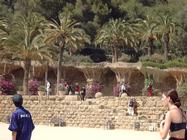
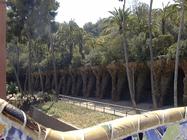
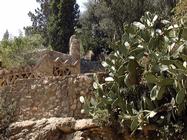 Landscaped walkways through the park. Gaudí wanted the roads and
walkways to harmonize with the natural surroundings.
Landscaped walkways through the park. Gaudí wanted the roads and
walkways to harmonize with the natural surroundings.
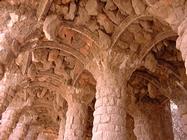 Detail of the ceiling of one of the walkways.
Detail of the ceiling of one of the walkways.